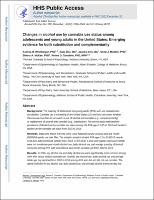Please use this identifier to cite or link to this item:
https://hdl.handle.net/20.500.12202/9424| Title: | Changes in alcohol use by cannabis use status among adolescents and young adults in the United States: Emerging evidence for both substitution and complementarity |
| Authors: | Weinberger, Andrea H. Zhu, Jiaqi Levin, Jacob Moeller, Scott J. McKee, Sherry A. Goodwin, Renee D. 0000-0002-7065-1349 |
| Keywords: | alcohol cannabis epidemiology young adults (YA) youth |
| Issue Date: | 2021 |
| Publisher: | Wiley Subscription Services, Inc. |
| Citation: | Weinberger, A. H., Zhu, J., Levin, J., Moeller, S. J., McKee, S. A., & Goodwin, R. D. (2021). Changes in alcohol use by cannabis use status among adolescents and young adults in the United States: Emerging evidence for both substitution and complementarity. Alcoholism: Clinical and Experimental Research, 45(12), 2536–2545. https://doi.org/10.1111/acer.14737 |
| Series/Report no.: | Alcoholism: Clinical and Experimental Research;45(12) |
| Abstract: | __Background__ The majority of adolescents and young adults (AYA) who use cannabis also use alcohol. Although cannabis use is increasing in the United States (US), it is not known whether the increase contributes to either increased co-use of alcohol and cannabis (e.g., complementarity) or replacement of alcohol with cannabis (e.g., substitution). The current study estimated the prevalence of alcohol use by cannabis use status among US AYA ages 12 to 25 in 2018 and trends in alcohol use by cannabis use status from 2002 to 2018. Methods Data were drawn from the 2002 to 2018 National Survey on Drug Use and Health public use data files. The analytic sample included AYA ages 12 to 25 (2018 sample, n = 26,924; total combined sample 2002 to 2018, n = 576,053). Linear and logistic regression models were used to estimate past-month alcohol use, daily alcohol use, and average quantity of alcohol consumed among AYA with and without past-month cannabis use from 2002 to 2018. Results In 2018, any alcohol use and daily alcohol use were significantly more common among AYA who used cannabis use than those who did not use cannabis. Overall, any alcohol use, daily alcohol use, and average drinks per day declined from 2002 to 2018 among AYA irrespective of recent cannabis use. However, the decline in any alcohol use, daily alcohol use, and average alcohol drinks per day was more rapid among AYA who used cannabis (daily and nondaily) than those who did not use cannabis. The rate of decline in average alcohol drinks per day was also higher among AYA with daily compared to nondaily cannabis use. __Conclusions__ Even with declines in alcohol use over time, drinking is much more common among AYA who report cannabis than those without recent cannabis use, which is consistent with complementarity. Yet, because the decline in alcohol use has been more rapid among AYA who use cannabis, there is also evidence of substitution. Thus, the current data on alcohol and cannabis use are consistent with both complementarity and substitution. However, these relationships may change as cannabis legalization expands over time. Article Note: Funding information This research was supported by National Institutes of Health/National Institute on Drug Abuse (NIH/NIDA) grant R01-DA20892 to Dr. Goodwin and National Institutes of Health/National Institute on Alcohol Abuse and Alcoholism (NIH/NIAAA) grant U54-AA027989 to Dr. McKee. CAPTION(S): Table S1-S5 Byline: Andrea H. Weinberger, Jiaqi Zhu, Jacob Levin, Scott J. Moeller, Sherry A. McKee, Renee D. Goodwin |
| Description: | Scholarly article / Open Access |
| URI: | https://www.ncbi.nlm.nih.gov/pmc/articles/PMC8742181/ https://hdl.handle.net/20.500.12202/9424 |
| ISSN: | 0145-6008 |
| Appears in Collections: | Ferkauf Graduate School of Psychology: Faculty Publications |
Files in This Item:
| File | Description | Size | Format | |
|---|---|---|---|---|
| Weinberger 2021 OA Changes in alcohol nihms-1754805.pdf | 236.29 kB | Adobe PDF |  View/Open |
This item is licensed under a Creative Commons License

